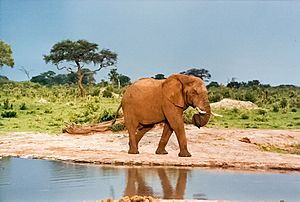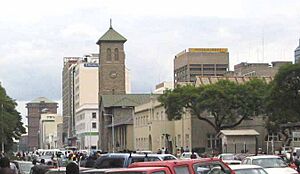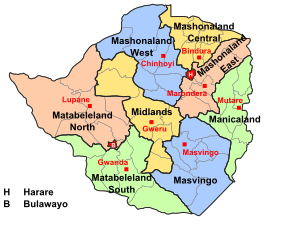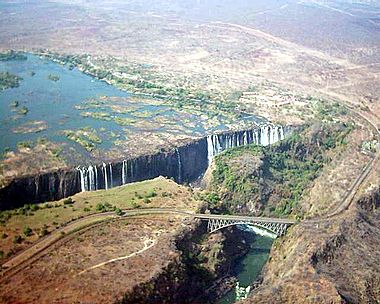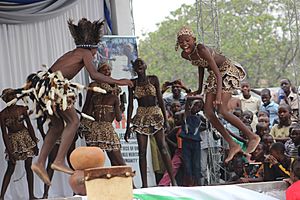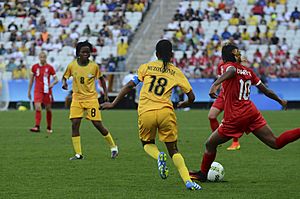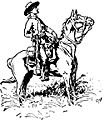Zimbabwe facts for kids
Quick facts for kids
Republic of Zimbabwe
|
|
|---|---|
|
|
|
|
Motto: "Unity, Freedom, Work"
|
|
|
Anthem: "Blessed be the land of Zimbabwe"
|
|
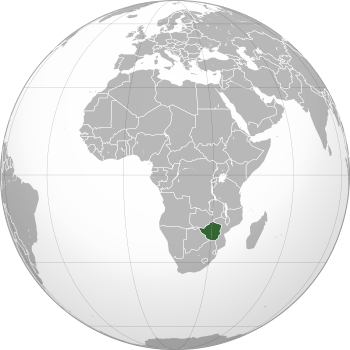
Location of Zimbabwe (dark green)
|
|
| Capital and largest city
|
Harare 17°49′45″S 31°03′08″E / 17.82917°S 31.05222°E |
| Official languages | 16 languages: |
| Ethnic groups
(2022 Census)
|
|
| Religion
(2017)
|
|
| Demonym(s) | Zimbabwean Zimbo (colloquial) |
| Government | Unitary presidential republic |
| Emmerson Mnangagwa | |
| Constantino Chiwenga | |
| Kembo Mohadi | |
| Legislature | Parliament |
| Senate | |
| National Assembly | |
| Independence from the United Kingdom | |
|
• Declared
|
11 November 1965 |
|
• Republic
|
2 March 1970 |
| 1 June 1979 | |
| 18 April 1980 | |
|
• Current constitution
|
15 May 2013 |
| Area | |
|
• Total
|
390,757 km2 (150,872 sq mi) (60th) |
|
• Water (%)
|
1 |
| Population | |
|
• 2024 January estimate
|
16,868,409 (73rd) |
|
• 2022 census
|
15,178,957 |
|
• Density
|
39/km2 (101.0/sq mi) |
| GDP (PPP) | 2023 estimate |
|
• Total
|
|
|
• Per capita
|
|
| GDP (nominal) | 2023 estimate |
|
• Total
|
|
|
• Per capita
|
|
| Gini (2019) | ▲ 50.3 high |
| HDI (2022) | medium · 159th |
| Currency | Zimbabwe Gold U.S. dollar ($) (USD) South African rand; Other currencies |
| Time zone | UTC+2 (CAT) |
| Date format | dd/mm/yyyy |
| Driving side | left |
| Calling code | +263 |
| ISO 3166 code | ZW |
| Internet TLD | .zw |
The Republic of Zimbabwe is a country in southern Africa. Its capital city is Harare.
Zimbabwe became an independent country on April 18, 1980. Every year, celebrations are held at the National Sports Stadium or Rufaro Stadium in Harare. During these celebrations, doves are set free to show peace. Fighter jets fly overhead, and the national anthem is sung. The president lights the flame of independence after parades. The president also gives a speech that is shown on TV.
Contents
Exploring Zimbabwe's Geography
Zimbabwe is a landlocked country. This means it has no coast on the sea. It is surrounded by other countries. These are Zambia, Botswana, South Africa, and Mozambique.
Zimbabwe is home to the amazing Victoria Falls. These huge waterfalls are part of the Zambezi River. The country is also named after Great Zimbabwe. This is an ancient stone city.
Plants and Animals of Zimbabwe
Zimbabwe has many different natural areas. These include woodlands, bushlands, and forests. The country is mostly savanna, which is like a grassland with scattered trees.
In the Eastern Highlands, you can find tropical forests. Trees like teak and mahogany grow there. You can also see huge strangler fig trees. In lower areas, you'll find mopane and giant baobab trees. Much of Zimbabwe is covered by miombo woodland. This is a type of forest with many brachystegia trees.
Zimbabwe has many beautiful flowers and shrubs. Some examples are hibiscus, flame lily, and wisteria. There are about 350 different kinds of mammals in Zimbabwe. You can also find many snakes, lizards, and over 500 types of birds. There are 131 kinds of fish too!
Sadly, some forests have been lost in Zimbabwe. This is due to trees being cut down and poaching (illegal hunting). More people, growing cities, and using wood for fuel also cause problems. This leads to soil erosion, which means fertile soil washes away.
A Look at Zimbabwe's History
Around the 9th century, the Bantu people built the city of Great Zimbabwe. This city became a major trade center by the 11th century. Later, the Kingdom of Zimbabwe, Rozvi, and Mutapa empires grew.
In 1890, the British South Africa Company took control of the area. This company was led by Cecil Rhodes. The region was named Rhodesia. In 1923, it became a British colony called Southern Rhodesia.
In 1965, the white minority government declared independence. They called the country Rhodesia. But in 1980, African citizens gained full equality. The country's name was officially changed to Zimbabwe.
Robert Mugabe led Zimbabwe for 37 years. He was first Prime Minister, then President. While he was first elected fairly, he later made many difficult laws. On November 21, 2017, Mugabe resigned. Emmerson Mnangagwa has been Zimbabwe's president since then.
How Zimbabwe is Governed
Zimbabwe is a republic. This means the people elect their leaders. It has a presidential system of government. This means the president is both the head of state and head of government.
Zimbabwe's government has a Parliament. This Parliament has two parts: the Senate (upper house) and the National Assembly (lower house).
Languages Spoken in Zimbabwe
Zimbabwe has many official languages. The main ones include Shona, Ndebele, and a special kind of Zimbabwean English. Other languages spoken are Venda, Manyika, Nyanja, and Chagani.
Zimbabwe's Economy
Zimbabwe uses several different currencies. The government mainly uses the United States dollar. The economy has faced some challenges.
Many people in Zimbabwe work in farming. They grow crops like maize, rice, and cotton. They also raise animals like cattle and chickens.
Mining is another important part of the economy. Zimbabwe has minerals like gold, copper, and chrome.
Manufacturing also takes place. Factories make things like iron, steel, and textiles. They also process food and tobacco.
Tourism is important too. Many visitors come to see Victoria Falls and the country's national parks.
Regions of Zimbabwe
Zimbabwe is divided into 8 provinces. There are also 2 cities that act like provinces.
| Province | Capital City |
|---|---|
| Bulawayo | Bulawayo |
| Harare | Harare |
| Manicaland | Mutare |
| Mashonaland Central | Bindura |
| Mashonaland East | Marondera |
| Mashonaland West | Chinhoyi |
| Masvingo | Masvingo city |
| Matabeleland North | Lupane District |
| Matabeleland South | Gwanda |
| Midlands | Gweru |
Major Cities in Zimbabwe
|
Largest cities or towns in Zimbabwe
Source: |
||
|---|---|---|
| Rank | Pop. | |
| 1 | Harare | 2,123,132 |
| 2 | Bulawayo | 1,200,337 |
| 3 | Chitungwiza | 371,244 |
| 4 | Mutare | 224,802 |
| 5 | Gweru | 158,200 |
| 6 | Kwekwe | 119,863 |
| 7 | Kadoma | 116,300 |
| 8 | Ruwa | 94,083 |
| 9 | Chinhoyi | 90,800 |
| 10 | Masvingo | 90,286 |
Visiting Zimbabwe: Tourism
Zimbabwe has many great places to visit. Victoria Falls is one of the most famous. It is shared with Zambia and is thought to be the largest waterfall in the world. The Victoria Falls National Park is also nearby. This park is one of Zimbabwe's eight main national parks. The biggest park is Hwange National Park.
Lake Kariba is another popular spot. It is the largest man-made lake in the world.
The Eastern Highlands are a beautiful mountain range. Here you can find Mount Nyangani, the highest peak in Zimbabwe. You can also visit the Bvumba Mountains and Nyanga National Park. From a place called World's View, you can see very far on a clear day.
Zimbabwe also has ancient ruined cities built from stone. The most famous are the Great Zimbabwe ruins in Masvingo. Other ruins include Khami and Dhlo-Dhlo.
The Matobo Hills are unique granite hills. They are south of Bulawayo. These hills were formed billions of years ago. They are known for their interesting shapes and wildlife.
Zimbabwean Culture
Zimbabwe has many different cultures. The Shona people are a large group. Their beliefs and ceremonies are very important. Shona people are also known for their beautiful sculptures and carvings.
Delicious Zimbabwean Food

Like in many African countries, Zimbabweans eat a few main foods. "Mealie meal" (cornmeal) is used to make sadza or isitshwala. This is a thick paste. It is usually eaten for lunch or dinner. People eat it with gravy, vegetables like spinach, beans, and meat.
Sadza is also eaten with sour milk, called "lacto." Another popular side is dried Tanganyika sardine, known as kapenta.
A thinner porridge called bota is often eaten for breakfast. It can be flavored with peanut butter, milk, or jam.
For family gatherings like weddings, a goat or cow is often cooked. It is usually barbecued or roasted.
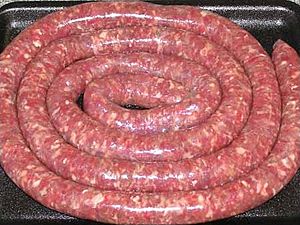
Some foods from the Afrikaner culture are also popular. Biltong is a dried, spiced meat snack, similar to jerky. Boerewors is a long, spiced beef sausage. It is often barbecued and served with sadza.
Because Zimbabwe was once a British colony, some English eating habits are also common. Many people have porridge in the morning. They might also have "10 o'clock tea" and "4 o'clock tea." Lunch often includes leftovers, fresh sadza, or sandwiches.
Other foods like rice, pasta, and potatoes are also part of Zimbabwean meals. A local favorite is rice cooked with peanut butter. A traditional dish called mutakura mixes peanuts, boiled maize, and other beans.
Sports in Zimbabwe
Football (soccer) is the most popular sport in Zimbabwe. The national team, called The Warriors, has played in the Africa Cup of Nations five times. They have also won the COSAFA Cup six times.
Rugby union is also important. The national rugby team has played in the Rugby World Cup twice.
Cricket is very popular too. It used to be mainly played by the white minority. Now, many Zimbabweans enjoy it. Zimbabwe is one of the top cricket nations. Famous Zimbabwean cricketers include Andy Flower and Brendan Taylor.
Zimbabwe has won eight Olympic medals. One was in field hockey for the women's team in 1980. The swimmer Kirsty Coventry won seven medals in 2004 and 2008. She has also won many gold medals in swimming at the Commonwealth Games and All-Africa Games.
Other sports played in Zimbabwe include basketball, volleyball, and netball. People also enjoy squash, motorsport, and chess.
Related pages
Images for kids
-
Towers of Great Zimbabwe
-
The opening of the railway to Umtali in 1899.
-
Ian Smith signing the Unilateral Declaration of Independence on 11 November 1965 with his cabinet.
-
Bishop Abel Muzorewa signs the Lancaster House Agreement.
-
The Zambezi River in the Mana Pools National Park.
-
Robert Mugabe, President of Zimbabwe since 1980.
-
Victoria Falls, the end of the upper Zambezi and beginning of the middle Zambezi.
-
A n'anga (Traditional Healer) of the majority (70%) Shona people, holding a kudu horn trumpet
-
Baden-Powell's drawing of Chief of Scouts Burnham, Matobo Hills, 1896.
-
St George's College, Harare was established in 1896 by a French Jesuit
See also
 In Spanish: Zimbabue para niños
In Spanish: Zimbabue para niños




